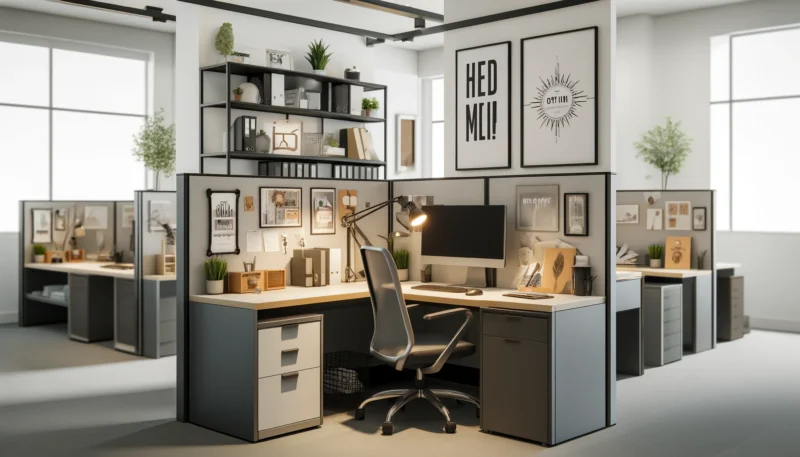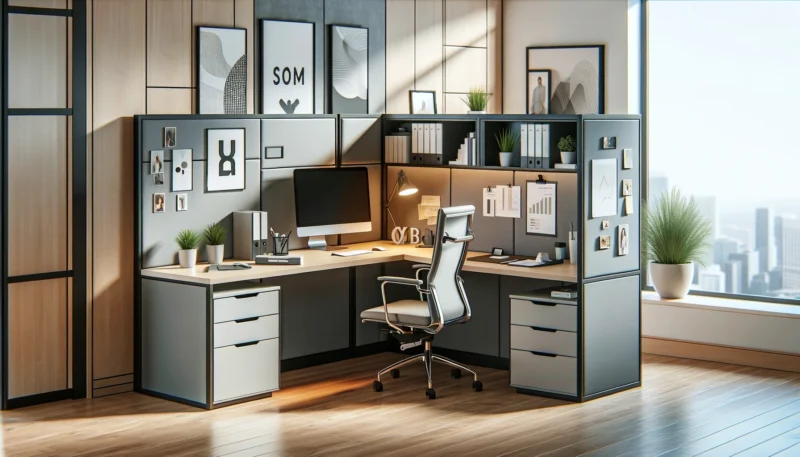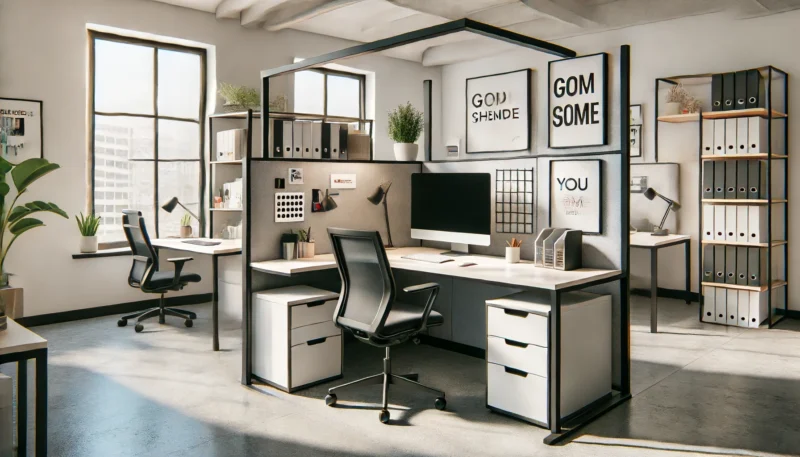I remember my first job after college. I walked into a sea of identical cubicles, each one a beige box with zero personality. The fluorescent lights buzzed overhead, casting a harsh glow on everything. It felt like stepping into a corporate maze, I was terrified. My enthusiasm for the job quickly faded as the environment sucked the creativity and productivity out of me.
Years later, as an office designer, I realized cubicles didn’t have to be this way. With the right design, cubicles can transform a workspace, boosting morale and productivity.
Adjustable chair and desk

Getting your workspace right starts with comfort. An adjustable chair and desk are must-haves for a comfortable and efficient cubicle. If you’re stuck sitting all day, having a chair that supports your back and a desk at the right height can save you from a lot of aches and pains.
It’s amazing what a difference a good ergonomic chair with lumbar support can make. Plus, an adjustable desk lets you switch between sitting and standing, which is great for keeping your blood flowing and avoiding those pesky muscle and joint issues.
Optimal monitor placement
Let’s talk about your monitors. Keeping them at eye level can really help prevent neck pain. They should be about an arm’s length away to reduce eye strain and help you maintain good posture. This setup also helps avoid repetitive strain injuries (RSIs), which are no fun at all.
If you’re using two monitors, make sure they’re both positioned properly to keep your workflow smooth and comfortable. Investing in adjustable monitor stands can give you that extra bit of flexibility to set things up just right for you.
Personal space

Let’s face it, nobody likes feeling cramped at work. Every cubicle should give you enough room to move around comfortably. Being stuck in a tiny space can make you feel trapped and stressed out. When you have enough room to breathe and spread out your stuff, it makes the workday a lot more pleasant.
Efficient storage solutions
Good storage is a game-changer. We all require spots to keep our personal items, work documents, and office supplies. Here’s how to achieve it:
- Ensure accessibility: Position shelves, drawers, and filing cabinets within easy reach to keep your desk tidy and clutter-free.
- Assign places: Designate a specific spot for each item to save time searching and increase productivity.
- Use clear or labeled storage: Opt for clear containers or labels to quickly locate what you require.
- Utilize vertical storage: Ideal for smaller cubicles, vertical storage maximizes organization without compromising accessibility.
Lighting for a productive environment
Natural light works wonders for our mood and productivity. Whenever you can, set up cubicles near windows to let in that lovely natural light. It cuts down on the need for artificial lights and makes the workspace feel more inviting.
Plus, natural light helps regulate our circadian rhythms, which means better sleep and overall well-being. It’s also easier on the eyes, reducing strain and headaches from staring at screens all day. If you can, use mirrors or reflective surfaces to spread that sunlight around the office more evenly.
Adjustable task lighting
Natural light is great, but sometimes we require a little extra help. Adjustable task lighting lets employees customize their workspace to their liking. Desk lamps with adjustable brightness and direction can create the perfect lighting for any task. This helps reduce glare and shadows, making it easier to see and cutting down on fatigue.
LED task lights are a smart choice because they’re energy-efficient and don’t get too hot. Dimmable lights are also a great addition, allowing folks to tweak the brightness based on their preferences and the time of day.
Soundproofing elements
Noise is a real productivity killer. Good cubicle design should include soundproofing elements to keep noise levels down. High cubicle walls, acoustic panels, and sound-absorbing materials can make a huge difference. These elements help block out noise between workspaces, making it easier to focus.
Acoustic ceiling tiles and carpets can also help by soaking up ambient sounds. And for those who are really sensitive to noise, offering noise-canceling headphones can be a lifesaver.
White noise machines
White noise machines are a great way to mask background noise and help people concentrate. They produce a steady sound that drowns out conversations and other distractions. This creates a more uniform sound environment, which can make sudden noises less jarring.
There are also mobile apps that offer various white noise options, so employees can pick what works best for them. Integrating white noise machines into the office can make the atmosphere calmer and more productive.
High cubicle walls
Privacy matters when you need to focus. High cubicle walls give you that sense of seclusion, helping you concentrate without feeling like everyone’s watching. These walls block both visual and noise distractions. You can even get custom cubicle walls with extra soundproofing for more privacy.
Frosted glass panels strike a nice balance, letting light in while keeping things private. Adding some artwork or motivational quotes can make your space feel more personal and comfortable.
They encourage personalization
Letting employees personalize their cubicles can really make a difference. Personal items, plants, and artwork can make the workspace feel more inviting and less like a sterile office. Encouraging personalization boosts morale and creates a more enjoyable work environment.
Employees can use bulletin boards or magnetic strips to display photos, notes, and other personal touches. Offering customizable storage options, like colored bins or decorative boxes, can enhance the personal feel of the cubicle. Personalization helps employees express their individuality, fostering a sense of belonging and engagement.
Integrating technology
Efficient cubicle design should include plenty of power outlets and USB ports to keep devices charged and ready. Well-placed outlets reduce the need for messy extension cords and make it easier to manage devices. Here are a few tips:
- Ensure there are enough outlets for all devices to prevent frustration and downtime.
- Wireless charging stations offer a convenient, clutter-free way to charge mobile devices.
- Surge protectors are essential to safeguard electronic equipment from power fluctuations and outages.
Effective cable management
Good cable management is key. Cable trays and clips keep cords organized and out of the way, improving the appearance of the workspace and reducing tripping hazards. Proper cable management also prevents tangling and ensures cords are easily accessible.
Using color-coded or labeled cables helps identify connections quickly, simplifying troubleshooting and maintenance. Under-desk cable management systems keep the workspace tidy and free from clutter, promoting a more efficient and professional environment.
Flexible design

Modular furniture is great for flexibility. Employees can adjust their cubicles to suit their needs, whether they need more desk space, extra storage, or a different layout. This adaptability accommodates changing team dynamics and project requirements.
Modular furniture allows for quick and cost-effective reconfigurations during office expansions or relocations. Offering a variety of modular components, like movable desks, shelves, and partitions, empowers employees to create a personalized and efficient workspace.
Collaborative spaces
Efficient office design includes spaces for collaboration, not just individual cubicles. Meeting rooms, breakout areas, and communal tables provide places for team discussions and brainstorming sessions. These spaces encourage spontaneous interactions and foster a culture of teamwork and innovation.
Designing collaborative spaces with comfortable seating, writable surfaces, and technology integration enhances their usability and appeal.
Flexible elements, like movable walls and furniture, allow for quick adjustments to suit different group sizes and activities. A mix of formal and informal collaborative areas caters to various work interactions and preferences.
The bottom line
Looking back at my early career experience, I’ve realized how important it is to have a well-designed cubicle. A good setup can really turn a boring, lifeless space into a lively and productive place to work.

